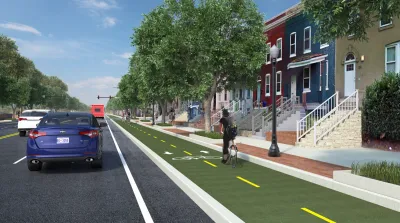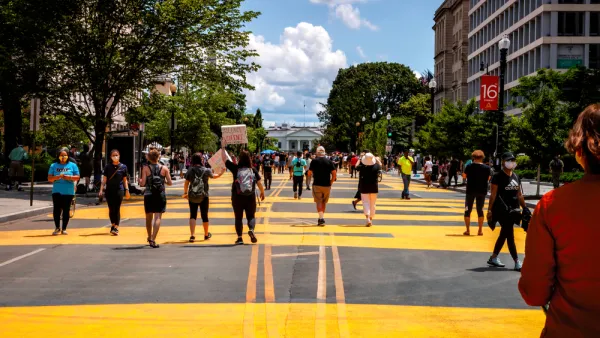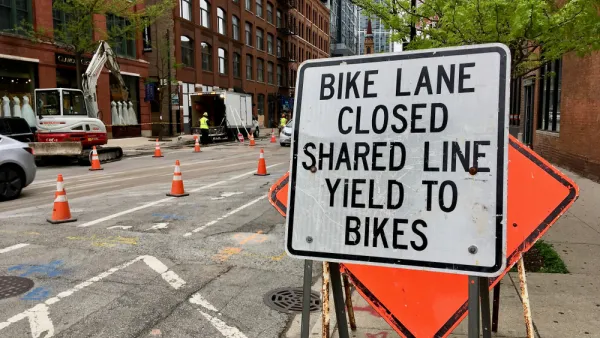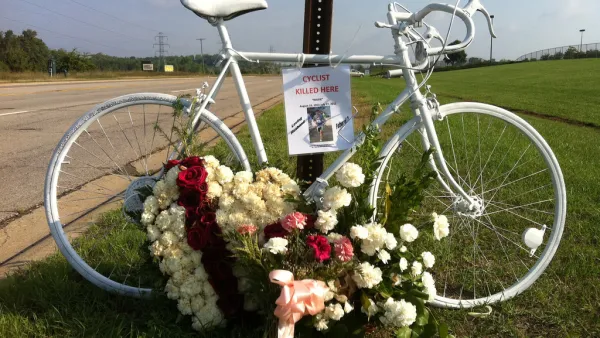Vision Zero is an ambitious goal, but it's impossible if traffic safety ideas aren't tested and implemented on the street.

Andrew Small reports from D.C., where the District Department of Transportation (DDOT) finally seems to be making progress on traffic safety programs after years of delays and frustration among Vision Zero boosters in the District.
Last year, the news three years into DDOT's Vision Zero was not good: "By that point in the year, 34 people overall had died on the city’s roads—D.C.’s worst year for traffic deaths in a decade," according to Small. Meanwhile projects were still several months away in the development pipeline and members of the District Council were getting frustrated with DDOT officials at a public hearing.
Fast forward to November 2019, and it's possible to report some progress. "In 2019, DDOT established a Vision Zero Office, fast-tracked quick-build safety projects like adding plastic pylons at crosswalks to slow drivers turns, and piloted some new ideas, such as dedicated bus lanes or painted curb extensions, that could be executed with little more than a can of paint," reports Small. The traffic safety statistics have also improved: "So far, 21 people have died from road crashes this year in the District, putting the city on track for the lowest number of traffic fatalities since the city committed to Vision Zero in 2015."
The article includes a lot more detail on the local political context for Vision Zero, the projects moving the needle for traffic safety, and the challenges for a true commitment to traffic safety, beyond the positive public relations benefit of announcing a Vision Zero campaign.
FULL STORY: Are D.C.'s Streets Finally Getting Safer?

National Parks Layoffs Will Cause Communities to Lose Billions
Thousands of essential park workers were laid off this week, just before the busy spring break season.

Retro-silient?: America’s First “Eco-burb,” The Woodlands Turns 50
A master-planned community north of Houston offers lessons on green infrastructure and resilient design, but falls short of its founder’s lofty affordability and walkability goals.

Delivering for America Plan Will Downgrade Mail Service in at Least 49.5 Percent of Zip Codes
Republican and Democrat lawmakers criticize the plan for its disproportionate negative impact on rural communities.

Test News Post 1
This is a summary

Test News Headline 46
Test for the image on the front page.

Balancing Bombs and Butterflies: How the National Guard Protects a Rare Species
The National Guard at Fort Indiantown Gap uses GIS technology and land management strategies to balance military training with conservation efforts, ensuring the survival of the rare eastern regal fritillary butterfly.
Urban Design for Planners 1: Software Tools
This six-course series explores essential urban design concepts using open source software and equips planners with the tools they need to participate fully in the urban design process.
Planning for Universal Design
Learn the tools for implementing Universal Design in planning regulations.
EMC Planning Group, Inc.
Planetizen
Planetizen
Mpact (formerly Rail~Volution)
Great Falls Development Authority, Inc.
HUDs Office of Policy Development and Research
NYU Wagner Graduate School of Public Service





























